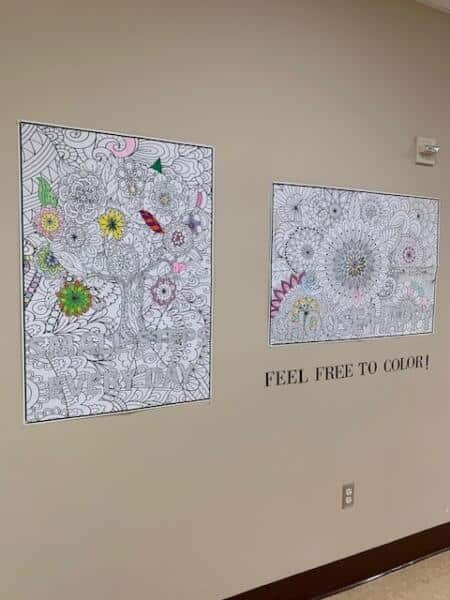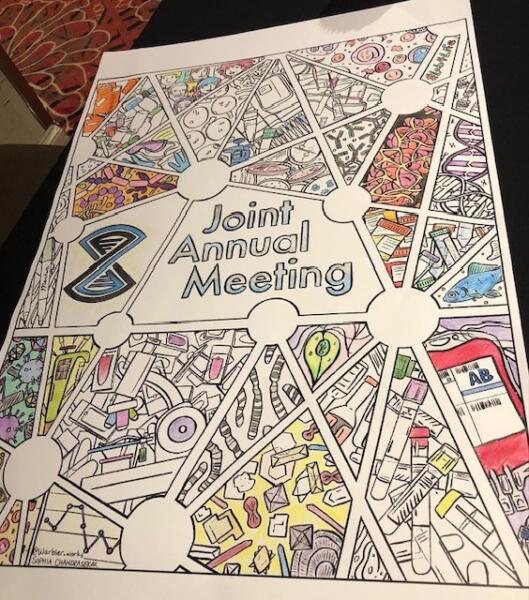Volume 38 Number 5 | October 2024
Addressing Burnout and Stress in College Healthcare Students and Educators
Phyllis Ingham, EdD, MLS(ASCP)CM, AHI(AMT), ASCLS Clinical Laboratory Educators Forum Chair

Understanding Burnout and Stress in Healthcare Education
Recent studies reveal alarming rates of burnout among college healthcare students. According to a 2022 survey by the American College Health Association (ACHA), approximately 60 percent of healthcare students reported experiencing high levels of stress, with 45 percent indicating symptoms of burnout. Four out of five college students report experiencing burnout during their undergraduate experience. Handshake reported 60 percent of all college students experience some level of academic burnout. The National College Health Assessment states 80 percent of college students reported feeling overwhelmed, and 40 percent had difficulty functioning. These figures are higher than those in the general student population, underscoring the unique pressures faced by future healthcare professionals.
Educators are not immune to these challenges. A 2022 study published in the Journal of Medical Education highlighted that 55 percent of healthcare educators reported moderate to severe burnout. Factors contributing to educator burnout include heavy workloads, administrative responsibilities, and the emotional toll of supporting struggling students.
Symptoms and Issues Caused by Burnout
Burnout manifests through a wide range of symptoms, which can be categorized into physical, emotional, and behavioral aspects.
- Physical: Chronic fatigue is one of the most common indicators, where individuals feel tired even after adequate rest. Other physical symptoms include headaches, gastrointestinal problems, and changes in sleep patterns. Students might report feeling perpetually exhausted, often unable to keep up with their coursework and clinical rotations.
- Emotional: Emotional exhaustion is a hallmark of burnout. This can include feelings of detachment, cynicism, and a sense of helplessness. Students and educators may experience a loss of motivation and enthusiasm for their studies or teaching responsibilities. Increased irritability and mood swings are also common, affecting personal and professional relationships.
- Cognitive: Difficulty concentrating, memory problems, and a decline in academic performance are significant cognitive symptoms. Students may struggle to retain information, leading to poor grades and academic setbacks. Educators might find it challenging to plan and deliver effective lessons, impacting the learning experience of their students.
- Behavioral: Behavioral changes include withdrawal from social interactions, procrastination, and neglecting responsibilities. Students might isolate themselves from peers, skip classes, and miss deadlines. Educators may show a lack of engagement in faculty meetings, avoid collaboration with colleagues, and reduce their involvement in student activities.
The consequences of burnout are far-reaching and multifaceted, impacting both individual well-being and institutional effectiveness.
- For Students: Persistent burnout can lead to academic failure, causing students to fall behind or drop out of their programs. This not only affects their immediate educational goals but also their long-term career prospects. Chronic stress and burnout can result in long-term mental health issues, such as anxiety, depression, and substance abuse. The strain of balancing academic demands with personal life can also lead to strained relationships with family and friends, exacerbating feelings of isolation and loneliness.
- For Educators: Burnout in educators can result in decreased job satisfaction, leading to higher turnover rates. This turnover disrupts the continuity of education and mentorship that is crucial for student success. Educators experiencing burnout may exhibit reduced teaching effectiveness, failing to engage students or provide the necessary support. This can diminish the overall quality of education, as students do not receive the guidance and instruction they need to excel. Additionally, educators who are burned out are less likely to participate in professional development opportunities, further hindering their growth and effectiveness.
- For Educational Institutions: The ripple effects of burnout extend to the entire educational system. High turnover rates among educators increase recruitment and training costs for institutions. A decline in teaching quality can result in lower student satisfaction and retention rates, ultimately affecting the institution’s reputation and financial stability. Furthermore, inadequately prepared students entering the healthcare workforce can compromise the quality of future healthcare delivery, potentially putting patient care at risk.
Addressing Burnout: Remedies and Practical Applications
How can we assist our students?
- Time Management and Organization: Teaching students effective time management skills can help them balance academic, clinical, and personal responsibilities. Tools such as planners, digital calendars, and time-blocking techniques can be beneficial.
- Mental Health Support: Providing access to mental health resources, including counseling services, stress management workshops, and peer support groups, can offer students the necessary support to navigate their challenges.
- Mindfulness and Relaxation Techniques: Encouraging mindfulness practices, such as meditation, deep breathing exercises, and yoga, can help students manage stress and improve their overall well-being.
- Healthy Lifestyle Choices: Promoting regular physical activity, balanced nutrition, and adequate sleep can enhance students’ resilience to stress.
- Academic Support: Offering academic support services, such as tutoring, study groups, and skills workshops, can help students feel more confident and capable in their studies.
- Interactive Classroom Activities: Incorporate activities such as role-playing, simulation exercises, and group discussions to make learning more engaging and reduce monotony.
- Peer Mentoring Programs: Establishing peer mentoring programs can provide students with guidance and support from upperclassmen who have successfully navigated similar challenges.
How can we assist our educators?
- Professional Development: Providing opportunities for educators to engage in professional development can help them stay current with teaching methods, reduce feelings of stagnation, and enhance job satisfaction.
- Workload Management: Institutions should strive to distribute workloads more equitably and consider implementing policies that limit excessive administrative tasks, allowing educators to focus more on teaching and mentoring.
- Support Networks: Establishing support networks, such as mentorship programs and faculty peer groups, can create a sense of community and provide outlets for sharing challenges and solutions.
- Self-Care and Wellness Programs: Encouraging educators to prioritize self-care and participate in wellness programs can help them manage stress and prevent burnout. Institutions can offer wellness workshops, access to fitness facilities, and mental health days.
- Recognition and Rewards: Acknowledging and rewarding educators’ efforts and achievements can boost morale and motivation. Simple gestures of appreciation, awards, and public recognition can make a significant difference.
- Flexible Teaching Methods: Using a variety of teaching methods, including flipped classrooms and hybrid learning models, can reduce the repetitive nature of lectures and keep both students and educators engaged.
- Collaborative Teaching: Encouraging team teaching can help distribute the workload and provide a support system for educators, reducing individual stress and fostering a collaborative environment.
Addressing burnout and stress among healthcare students is not only crucial for their academic success but also for their future professional effectiveness. Learning to manage stress and prevent burnout during their educational journey equips students with the skills necessary to handle the high-stress environments they will encounter in their healthcare careers.
Current Burnout in Healthcare Professionals
Burnout is a significant issue within the broader healthcare community, affecting various professions, including nurses, physicians, and laboratory professionals. A recent report by the National Academy of Medicine highlighted that burnout affects 35 to 54 percent of nurses and physicians in the United States. Similarly, a study published in the Journal of Clinical Laboratory Science reported that 52 percent of laboratory professionals experience moderate to severe burnout due to high workload, emotional demands, and insufficient support.
High levels of stress and burnout among healthcare professionals lead to increased medical errors, reduced quality of patient care, and higher turnover rates. For example, the same National Academy of Medicine report found that burnout among healthcare providers is associated with a 20 percent increase in the likelihood of making a significant medical error. Furthermore, healthcare professionals experiencing burnout are twice as likely to leave their job within the next two years compared to their less stressed counterparts.
By equipping students with effective stress management strategies, educational institutions can contribute to better patient care outcomes and a more sustainable healthcare workforce. Teaching stress resilience and coping mechanisms not only helps students succeed academically but also prepares them to thrive in their future careers, ultimately enhancing the quality of care they provide to patients.
Fostering a Supportive Environment
Creating a supportive environment is crucial for mitigating burnout among both students and educators. Institutions should prioritize open communication, allowing individuals to voice their concerns and suggestions without fear of stigma or retribution. Regularly assessing the mental health and well-being of students and staff through surveys and feedback mechanisms can help identify areas needing improvement.
Fostering a culture of empathy and understanding within the educational community can go a long way in reducing burnout. Encouraging collaborative efforts, where students and educators work together to address stressors and develop solutions, can strengthen the sense of belonging, unity, and mutual support.
Conclusion
Addressing burnout and stress in college healthcare students and educators is not just a matter of individual well-being; it is essential for the sustainability and quality of healthcare education. By recognizing the symptoms, understanding the issues, and implementing practical remedies, institutions can create a healthier, more resilient educational environment. Breaking the silence on burnout is the first step towards building a future where both students and educators can thrive and achieve their goals. Together—united—we can do so much more!
References
- American College Health Association. (2022). National College Health Assessment: Undergraduate Student Reference Group Executive Summary Spring 2022. American College Health Association.
- Chessman, H. (2023). Effective Strategies for Combating Faculty Burnout. Higher Education Today. Retrieved from: https://www.higheredtoday.org/2023/05/18/effective-strategies-for-combating-faculty-burnout/ June 17, 2024.
- Handshake Blog. (2024). College Students and Academic Burnout.
- Jagodics, B., Szabo, E. Student Burnout in Higher Education: A Demand-Resource Model Approach. Trends in Psychol. 31, 757-756 (2023).
- Kosmin, J. (2023). Stress vs. Burnout: Addressing Burnout Among College Students. Retrieved from: https://www.malvernbh.com/blog/burnout-among-college-students/ June 17, 2024.
- Razai, M., Kooner, P., Majeed, A. (2023). Journal of Primary Care & Community Health. Strategies and Interventions to Improve Healthcare Professionals’ Well-Being and Reduce Burnout.
- Peters, D., & Rajasingam, D. (2019). Burnout in healthcare: medical educators’ role. BMJ, 366, l5570. https://doi.org/10.1136/bmj.l5570
- Schwartz, N. (2023). Survey: Over 4 in 5 college seniors report burnout during undergraduate experience. Retrieved from https://www.highereddive.com/news/survey-over-4-in-5-college-seniors-report-burnout-during-undergraduate-exp/692208/ on June 17, 2024.
Phyllis Ingham is Medical Laboratory Technology and Phlebotomy Program Director at West Georgia Technical College in Waco, Georgia.
West Georgia Technical College advances initiatives to reduce stress and burnout among healthcare students. Pictured from top: Our nursing program set up a “coloring wall.” The MLT program sponsored a “Piece Together Peace” puzzle challenge. At the 2024 ASCLS, AGT & SAFMLS Joint Annual Meeting a coloring sheet was available for conference participants to take a mindful moment. These are great examples of activities to “take a minute” to unwind during a busy day.



